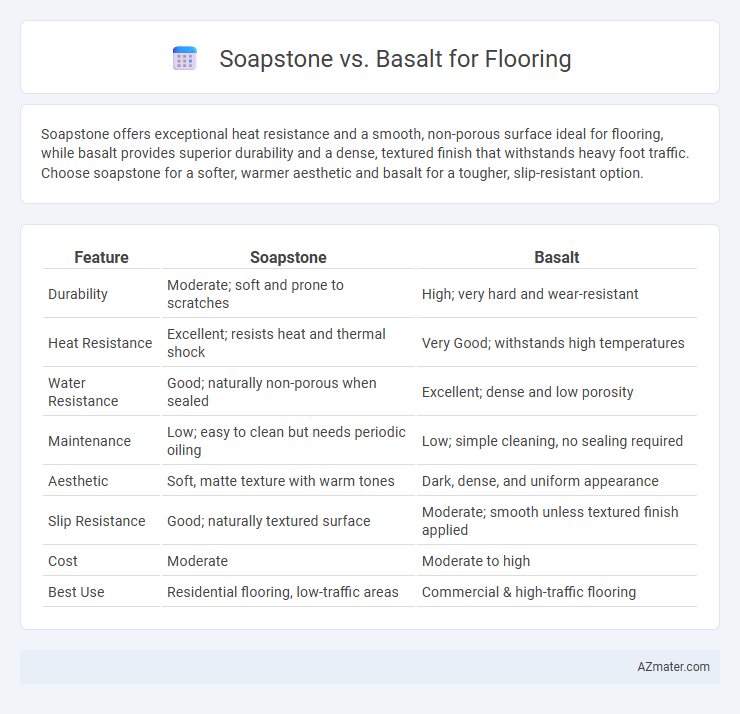Soapstone offers exceptional heat resistance and a smooth, non-porous surface ideal for flooring, while basalt provides superior durability and a dense, textured finish that withstands heavy foot traffic. Choose soapstone for a softer, warmer aesthetic and basalt for a tougher, slip-resistant option.
Table of Comparison
| Feature | Soapstone | Basalt |
|---|---|---|
| Durability | Moderate; soft and prone to scratches | High; very hard and wear-resistant |
| Heat Resistance | Excellent; resists heat and thermal shock | Very Good; withstands high temperatures |
| Water Resistance | Good; naturally non-porous when sealed | Excellent; dense and low porosity |
| Maintenance | Low; easy to clean but needs periodic oiling | Low; simple cleaning, no sealing required |
| Aesthetic | Soft, matte texture with warm tones | Dark, dense, and uniform appearance |
| Slip Resistance | Good; naturally textured surface | Moderate; smooth unless textured finish applied |
| Cost | Moderate | Moderate to high |
| Best Use | Residential flooring, low-traffic areas | Commercial & high-traffic flooring |
Introduction: Soapstone vs Basalt Flooring
Soapstone and basalt are popular natural stone choices for flooring, each offering unique durability and aesthetic qualities. Soapstone features a smooth, matte finish with excellent resistance to stains and heat, making it ideal for kitchens or bathrooms. Basalt, a dense volcanic rock, provides superior hardness and a sleek, dark appearance that enhances modern and industrial interior designs.
Composition and Origin of Soapstone and Basalt
Soapstone, primarily composed of talc, chlorite, and magnesite, is a metamorphic rock formed from the alteration of ultramafic rocks under low-grade metamorphism, resulting in a soft, heat-resistant surface ideal for flooring applications. Basalt, an extrusive igneous rock rich in plagioclase and pyroxene minerals, originates from the rapid cooling of lava at the Earth's surface and offers exceptional durability and hardness for high-traffic flooring. The distinct geological formations and mineral compositions of soapstone and basalt influence their texture, resilience, and maintenance requirements in flooring installations.
Appearance and Color Variations
Soapstone flooring showcases a smooth, matte surface with soft, muted tones ranging from light gray to deep charcoal, often featuring subtle veining and occasional green or bluish undertones. Basalt flooring offers a more uniform appearance with a dense, fine-grained texture and predominantly dark shades, including deep black and dark gray, sometimes with hints of brown or rust. Both materials provide distinct aesthetic choices, with soapstone delivering a warmer, more natural look, while basalt exudes a sleek, modern appeal through its consistent coloration.
Durability and Hardness Comparison
Soapstone offers moderate durability with a Mohs hardness of around 1 to 2.5, making it softer and more prone to scratches compared to basalt. Basalt flooring, with a higher Mohs hardness of 6 to 7, provides superior durability and resistance to wear, making it ideal for high-traffic areas.
Slip Resistance and Safety
Soapstone offers superior slip resistance due to its naturally textured, matte surface, making it a safer choice for flooring in wet or high-traffic areas. Basalt, while durable and visually striking with its dark, uniform appearance, can become slippery when polished, posing potential safety risks. Prioritizing slip resistance, soapstone enhances safety without compromising durability, making it ideal for flooring applications where traction is critical.
Maintenance and Cleaning Requirements
Soapstone flooring requires minimal maintenance due to its resistance to stains and moisture, needing only regular dusting and occasional wiping with mild soap and water to preserve its matte finish. Basalt flooring demands more frequent cleaning to prevent dirt buildup in its dense, fine-grained surface, often requiring pH-neutral cleaners and periodic sealing to maintain its durability and appearance. Both materials benefit from prompt spill cleanup, but soapstone's natural non-porosity offers greater ease in long-term upkeep compared to basalt.
Temperature Resistance and Comfort
Soapstone offers excellent temperature resistance with its natural ability to absorb, retain, and evenly radiate heat, making it ideal for radiant floor heating systems and providing a warm, comfortable surface underfoot. Basalt, a dense volcanic rock, also excels in temperature stability and thermal conductivity but tends to feel cooler to the touch, which may be less comfortable in colder climates. Both materials are highly durable, but soapstone's unique heat retention properties contribute significantly to enhanced flooring comfort and energy efficiency.
Installation Process and Considerations
Soapstone flooring offers a smooth surface that is relatively easy to cut and shape during installation, making it a preferred choice for projects requiring intricate designs. Basalt, being a harder volcanic rock, demands specialized tools and experienced installers to handle its dense, tough composition, which can increase labor costs and time. Both materials require a proper subfloor and sealing to prevent moisture absorption, but soapstone's natural flexibility allows it to better withstand slight structural movements compared to the more rigid basalt.
Cost Comparison: Soapstone vs Basalt
Soapstone flooring generally costs between $15 and $30 per square foot, making it a moderately priced natural stone option with high durability and heat resistance. Basalt, typically priced from $10 to $25 per square foot, offers a more affordable alternative with excellent hardness and slip resistance. Installation costs for both stones vary but tend to be slightly higher for basalt due to its density and weight, influencing the overall budget for flooring projects.
Pros and Cons for Flooring Applications
Soapstone offers excellent thermal insulation, natural slip resistance, and chemical resistance, making it ideal for comfortable and safe flooring in kitchens and bathrooms. It is softer and more prone to scratches compared to basalt, requiring regular maintenance and sealing to preserve its appearance. Basalt, a dense volcanic rock, provides superior durability, hardness, and resistance to wear, suitable for high-traffic areas, but it can be more expensive and challenging to cut and install due to its brittleness.

Infographic: Soapstone vs Basalt for Flooring
 azmater.com
azmater.com